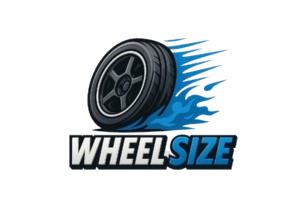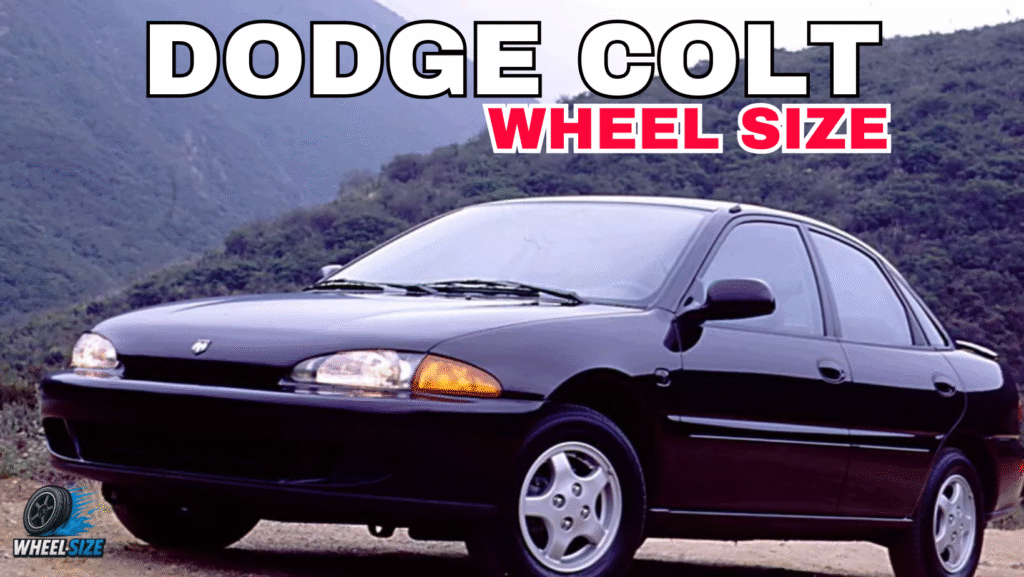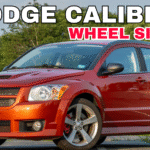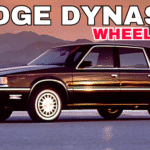Among those lost jewels in the small car market is the Dodge Colt. Originally launched in 1971 and running until 1995, it discreetly developed a reputation as a reasonably priced, quick, and shockingly changeable ride. Designed from a collaboration between Chrysler and Mitsubishi, the Colt arrived in front- and rear-wheel-drive models with modifications affecting everything from drivability to wheel fitment. Knowing the Colt’s generational wheel parameters is essential, whether your project is a resto-mod or a daily driver fresh-up. Every generation brought its unique bolt pattern, rim size, hub bore, offset, and tire range; thus, obtaining the fitment right counts not only for appearance but also for safety and performance.
Dodge Colt Wheel Fitment Overview
Over the seven-generation run of the Dodge Colt, the wheel parameters changed significantly. Early in the 1970s, the RWD Colts carried 13-inch rims, a broad 67.1 mm hub bore, and a 4x 114.3 bolt pattern. These early configurations made use of small tires, like 155SR13s or 165SR13s. Wheel dimensions started dropping in bore but increasing in offset as the Colt switched to FWD systems in the late 1970s and early 1980s. Standard from the mid-1980s forward, the 4×100 bolt design was matched with a 56.1 mm hub bore. Rim widths rose too; some later models rode on low-profile 195/55R15 tires and 15-inch wheels. From about +30 mm in past years, offset levels climbed to about +45 mm in final models. Choosing the correct wheel arrangement depends much on knowing the generation you belong to.
Dodge Colt Gen 1 (1971–1973)
Based on the Mitsubishi Galant, this was the Colt’s debut on American markets. Its RWD arrangement was classic, and its design was simple. The factory wheel configuration consisted of 13×4.5-inch steel wheels, a 4×114.3 mm bolt pattern, and narrow 155SR13 or 165SR13 tires. The wheels slid nicely under the thin fenders, thanks in part to a large 67.1 mm hub bore and a +35 mm offset. Although performance wasn’t great, the car’s lightweight construction made a leisurely drive enjoyable. Retro JDM style aficionados typically search for antique aftermarket wheels that fit the bolt pattern. Staying around the original offset and using hub-centric rings if necessary is wise while upgrading. This prevents damaging suspension components and keeps the ride seamless.
| Year | Hub Bore (mm) | Bolt Pattern (PCD) | Thread Size | OEM Tire Size | OEM Rim Size | Offset Range (mm) | Tire Pressure (F/R, bar) | Aftermarket Wheel Size Range |
|---|---|---|---|---|---|---|---|---|
| 1971 | 67.1 | 4×114.3 | M12 x 1.5 | 6.00-13 Bias Ply / 165R13 | 13×4.5″ | +35 | 1.8 / 1.9 | 13″–14″ |
| 1972 | 67.1 | 4×114.3 | M12 x 1.5 | 6.00-13 Bias Ply / 165R13 | 13×4.5″ | +35 | 1.8 / 1.9 | 13″–14″ |
| 1973 | 67.1 | 4×114.3 | M12 x 1.5 | 6.00-13 Bias Ply / 165R13 | 13×4.5″ | +35 | 1.8 / 1.9 | 13″–14″ |
Dodge Colt Gen 2 (1974–1977)
The second generation saw the Colt retain its RWD architecture while somewhat increasing in scale. Now supported 13×5.0-inch rims as standard, it retained the same 4x 114.3 mm bolt pattern and 67.1 mm hub bore. Common tire choices for this period were 165SR13 and 175/70R13, which provided a rather improved grip than the previous. The offset stayed somewhat near the +30 to +35 mm range. This iteration provided some extra comfort with the wider body and weight, but still drove like a little car ought to. To accentuate the nostalgic look while keeping OEM geometry, owners sometimes trade in classic aftermarket wheels like old Enkeis or RS Watanabes. Maintaining current stock offset values guarantees you won’t impair the already limited suspension travel.
| Model | Bolt Pattern | Hub Bore | Offset | OEM Wheel | Aftermarket Wheel |
| 1974 Dodge Colt | 4×114.3mm | 67.1mm | +30–+35mm | 13×5.0″ | 13–14 Inch |
| 1975 Dodge Colt | 4×114.3mm | 67.1mm | +30–+35mm | 13×5.0″ | 13–14 Inch |
| 1976 Dodge Colt | 4×114.3mm | 67.1mm | +30–+35mm | 13×5.0″ | 13–14 Inch |
| 1977 Dodge Colt | 4×114.3mm | 67.1mm | +30–+35mm | 13×5.0″ | 13–14 Inch |
Dodge Colt Gen 3 (1977–1979)
By now, hatchback style inspirations were evident in this last RWD variant of the Colt. Wheel specs stayed the same from the last generation: still 13×5.0-inch wheels, a 67.1 mm hub bore, and a 4×114.3 mm bolt pattern. Factory tire sizing drew mostly on 175/70R13 rubber. Offset maintained at +35 mm. This model appealed more with visual changes and hatch variation, even if performance enhancements were limited. These vehicles are often seen getting the tuner treatment today with stylish suspension changes and period-correct wheels. Having said that, since the aged suspension system was not intended for wide current wheels, it is usually advisable to avoid dramatic offset modifications.
| Year | Hub Bore (mm) | Bolt Pattern (PCD) | Thread Size | OEM Tire Size | OEM Rim Size | Offset Range (mm) | Tire Pressure (F/R, bar) | Aftermarket Wheel Size Range |
|---|---|---|---|---|---|---|---|---|
| 1977 | 67.1 | 4×114.3 | M12 x 1.5 | 165/80R13 | 13×5.0″ | +35 | 1.9 / 2.0 | 13″–14″ |
| 1978 | 67.1 | 4×114.3 | M12 x 1.5 | 165/80R13 | 13×5.0″ | +35 | 1.9 / 2.0 | 13″–14″ |
| 1979 | 67.1 | 4×114.3 | M12 x 1.5 | 165/80R13 | 13×5.0″ | +35 | 1.9 / 2.0 | 13″–14″ |
Dodge Colt Gen 4 (1979–1984)
The Dodge Colt changed its handling and wheel fitting entirely by switching to a front-wheel-drive configuration with the fourth generation. Originally, most trims followed the 4×114.3 bolt pattern, but by the end of the generation,4×100 became more typical. Early models kept the 67.1 mm hub bore, then shifted to 56.1 mm. Base wheels were 13×5.0 inches; alloys with performance cuts measured 14×5.5-inch inches. Depending on trim and market, tire sizes ran from 175/70R13 to 185/60R14. Set offset to roughly +38 mm to fit FWD geometry. Particularly as the market adopted smaller FWD vehicles, this generation began to open additional aftermarket possibilities. Before adding anything aftermarket, just double-check the hub bore; if you’re mixing early and late cuts, you may require rings.
| Year | Hub Bore (mm) | Bolt Pattern (PCD) | Thread Size | OEM Tire Size | OEM Rim Size | Offset Range (mm) | Tire Pressure (F/R, bar) | Aftermarket Wheel Size Range |
|---|---|---|---|---|---|---|---|---|
| 1979 | 67.1 | 4×114.3 | M12 x 1.5 | 165/80R13 | 13×5.0″ | +38 | 1.9 / 2.0 | 13″–14″ |
| 1980 | 67.1 | 4×114.3 | M12 x 1.5 | 165/80R13 | 13×5.0″ | +38 | 1.9 / 2.0 | 13″–14″ |
| 1981 | 67.1 | 4×114.3 | M12 x 1.5 | 165/80R13 | 13×5.0″ | +38 | 1.9 / 2.0 | 13″–14″ |
| 1982 | 67.1 | 4×114.3 | M12 x 1.5 | 165/80R13 | 13×5.0″ | +38 | 1.9 / 2.0 | 13″–14″ |
| 1983 | 56.1 | 4×100 | M12 x 1.5 | 165/80R13, 175/70R13 (some trims) | 13×5.0″, 14×5.5″ | +38 | 1.9 / 2.0 | 13″–14″ |
| 1984 | 56.1 | 4×100 | M12 x 1.5 | 165/80R13, 175/70R13 (some trims) | 13×5.0″, 14×5.5″ | +38 | 1.9 / 2.0 | 13″–14″ |
Dodge Colt Gen 5 (1985–1988)
The fifth-generation Colt accepted the small FWD formula whole, and with that came more standardized specs everywhere. It used a 56.1 mm hub bore, a 4×100 mm bolt pattern, 13×5.0 and 14×5.5 inch wheel sizes. Depending on trim, the go-to tires were 175/70R13 and 185/60R14. Usually, offsets lie between +38 and +42 mm. Particularly, the GTS trim got larger wheels and lower-profile tires for a sportier feel. Wheel shopping became considerably simpler with the generally utilized bolt design and hub size. Make sure the offset stays acceptable, whether you’re choosing lightweight 14s or flush-fitting 15-inch configurations, to prevent rubbing or steering problems.
| Year | Hub Bore (mm) | Bolt Pattern (PCD) | Thread Size | OEM Tire Size | OEM Rim Size | Offset Range (mm) | Tire Pressure (F/R, bar) | Aftermarket Wheel Size Range |
|---|---|---|---|---|---|---|---|---|
| 1985 | 56.1 | 4×100 | M12 x 1.5 | 155/80R13 | 13×5.0″ | +38 to +42 | 1.9 / 2.0 | 13″–15″ |
| 1986 | 56.1 | 4×100 | M12 x 1.5 | 155/80R13 | 13×5.0″ | +38 to +42 | 1.9 / 2.0 | 13″–15″ |
| 1987 | 56.1 | 4×100 | M12 x 1.5 | 155/80R13 | 13×5.0″ | +38 to +42 | 1.9 / 2.0 | 13″–15″ |
| 1988 | 56.1 | 4×100 | M12 x 1.5 | 155/80R13 | 13×5.0″ | +38 to +42 | 1.9 / 2.0 | 13″–15″ |
Dodge Colt Gen 6 (1989–1992)
Sleeker looks and additional trim choices—including a GT with higher performance out of the box—were brought in by this generation. Wheel fitment also made sense. Bolt pattern stayed 4×100 mm, and hub bore stayed 56.1 mm. Rim diameters on base models vary from 13×5.0 to 15×6.0 on GT versions. Among the tire sizes were 195/55R15, 185/60R14, and 155/80R13. Varied in offset from +38 mm to +45 mm. Better chassis tuning and suspension enhancements make this generation a popular choice for aficionados wishing to create a budget-tuned vehicle. The 4×100 design fits a great variety of aftermarket wheels. Just be sure you are running hub-centric rings or matching the bore size to prevent vibrations at highway speeds.
| Year | Hub Bore (mm) | Bolt Pattern (PCD) | Wheel Fasteners | Thread Size | OEM Tire Size | OEM Rim Size | Offset Range (mm) | Tire Pressure (F/R, bar) | Aftermarket Wheel Size Range |
|---|---|---|---|---|---|---|---|---|---|
| 1989 | 56.1 | 4×100 | Lug nuts | M12 x 1.5 | 155SR13 | 4.5Jx13 ET46 | 44–48 | 1.8 | 13″–15″ |
| 1990 | 56.1 | 4×100 | Lug nuts | M12 x 1.5 | 155SR13 | 4.5Jx13 ET46 | 44–48 | 1.8 | 13″–15″ |
| 1991 | 56.1 | 4×100 | Lug nuts | M12 x 1.5 | 155SR13 | 4.5Jx13 ET46 | 44–48 | 1.8 | 13″–15″ |
| 1992 | 56.1 | 4×100 | Lug nuts | M12 x 1.5 | 155SR13 | 4.5Jx13 ET46 | 44–48 | 1.8 | 13″–15″ |
Dodge Colt Gen 7 (1993–1995)
Designed on the same basis as the Mitsubishi Mirage and Eagle Summit, the last Colt was the most polished. One of the easier versions to locate wheels for, it kept the 4×100 mm bolt pattern and 56.1 mm hub bore. Base versions had 15×6.0-inch wheels wrapped in 195/55R15 while DOHC levels featured 14×5.5-inch wheels wrapped in 175/70R13 or 185/60R14 tires. Offset ran from +40 mm to +46 mm. Many owners currently prefer 15-inch alloys with minor suspension lowers for both form and function; the car’s enhanced ride quality and handling offered it a better basis for wheel modifications. Stay within the offset range and, even with performance tires or coilovers, you won’t have any clearance issues.
| Year | Hub Bore (mm) | Bolt Pattern (PCD) | Thread Size | OEM Tire Size | OEM Rim Size | Offset Range (mm) | Tire Pressure (F/R, bar) | Aftermarket Wheel Size Range |
|---|---|---|---|---|---|---|---|---|
| 1993 | 56.1 | 4×100 | M12 x 1.5 | 155R13 | 5Jx13 ET46 | 44–48 | 1.8 | 13″–15″ |
| 1994 | 56.1 | 4×100 | M12 x 1.5 | 155R13 | 5Jx13 ET46 | 44–48 | 1.8 | 13″–15″ |
| 1995 | 56.1 | 4×100 | M12 x 1.5 | 155R13 | 5Jx13 ET46 | 44–48 | 1.8 | 13″–15″ |
Dodge Colt Bolt Pattern Chart by Year
To make it easier to reference, here’s a chart summarizing bolt pattern, rim size, hub bore, offset, and tire size for every Dodge Colt generation:
| Gen | Years | Bolt Pattern | Rim Size(s) | Hub Bore | Offset Range | Tire Sizes |
| 1 | 1971–1973 | 4×114.3 | 13×4.5″ | 67.1 mm | +35 mm | 155SR13, 165SR13 |
| 2 | 1974–1977 | 4×114.3 | 13×5.0″ | 67.1 mm | +30 to +35 | 165SR13, 175/70R13 |
| 3 | 1977–1979 | 4×114.3 | 13×5.0″ | 67.1 mm | +35 mm | 175/70R13 |
| 4 | 1979–1984 | 4×114.3/100 | 13×5.0″, 14×5.5″ | 67.1/56.1 | +38 mm | 175/70R13, 185/60R14 |
| 5 | 1985–1988 | 4×100 | 13×5.0″, 14×5.5″ | 56.1 mm | +38 to +42 | 175/70R13, 185/60R14 |
| 6 | 1989–1992 | 4×100 | 13×5.0″ to 15×6.0″ | 56.1 mm | +38 to +45 | 155/80R13, 185/60R14, 195/55R15 |
| 7 | 1993–1995 | 4×100 | 14×5.5″, 15×6.0″ | 56.1 mm | +40 to +46 | 175/70R13, 185/60R14, 195/55R15 |
Best Aftermarket Wheels for Dodge Colt
Particularly in its later models, the Dodge Colt’s small scale and lightweight frame make it an interesting foundation for personalizing. If you intend to upgrade, your best bet is in the 4×100 bolt pattern era—from 1985 on. Lightweight 15×6.5″ or 15×7″ wheels available from companies including Enkei, Konig, and Rota fit Gen 5, 6, and 7 Colts without rubbing problems. Wheel selections are more limited but still available for older generations (Gen 1–4) using the 4×114.3 design; check for traditional Japanese wheels like SSR or period-correct steelies.
Use hub-centric rings to remove vibrations; the center bore matches (67.1 mm for early gens and 56.1 mm for FWD variants). Also important is offset; remain between +35 and +45 mm to prevent suspension clearance problems. Wheel fitting greatly affects both appearance and handling, whether you are building a sleeper or refurbishing a classic Colt.
Common Fitment Issues and Fixes
When modifying a Dodge Colt, especially if you’re crossing generation lines, fitting problems are somewhat prevalent. One often occurring issue is a misaligned hub bore. Unless you utilize hub-centric rings, for example, putting a Gen 5+ wheel with a 56.1 mm bore on an older Colt results in off-center wheels. Another problem is offset; if you go too low, say, +20 m, —you run the danger of overloading your wheel bearings or rubbing on the inner fender.
While it’s a workaround, using spacers has to be done correctly. If you’re adjusting for brake clearance, stick to premium hub-centric spacers and longer wheel studs. Unless you are changing the fenders, keep the wheel width on older RWD vehicles under 6.5″. Additionally, be careful with deep-dish wheels; they look fantastic but often push the limits of safe offset for the Colt’s small suspension geometry.
FAQs
What is the Dodge Colt bolt pattern?
It is dependent on the generation. While Gen 5 and forward (1985–1995) changed to the more common 4×100, Early Colts (1971–1984) used a 4×114.33 bolt pattern.
Can I install 15-inch wheels on my Colt?
Correct. Especially on sport cuts, Gen 6 and Gen 7 Colts find 15×6.0″ wheels easy. Just be sure the tire size is about 195/55R15 and the offset falls between +38 and +46 mm.
What’s the hub bore on my Dodge Colt?
Hub bore of earlier RWD models is 67.1 mm. Later FWD generations bore 56.1 mm. Verify always before fitting aftermarket wheels.
Do I need spacers for aftermarket wheels?
Only if you need more fender clearance or your wheels have offsets creating internal suspension interference. Keep to premium spacers and long studs.
Are Gen 4 Colts 4×100 or 4×114.3?
Both both. Early Gen 4s ran 4x 114.3; later models switched to 4x 100. Verify always by looking at your VIN-based specs or by a visual measurement.
Conclusion
Although the Dodge Colt might have gone under notice, its development from a simple RWD sedan to a vibrant FWD hatchback offers it a special platform for wheel improvements. Getting your fitting perfect is about performance, safety, and lifespan, not only about appearances, as bolt patterns vary from 4×114.3 to 4×100 and offset ranges are becoming more refined over the years.
The correct wheels make all the difference whether you’re restoring an antique Colt or adding contemporary flair to your late-model Colt. Keep within the requirements of your generation, avoid ignoring hub bore or offset, and you will fully utilize the ride of your Dodge Colt.



